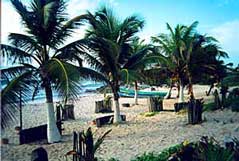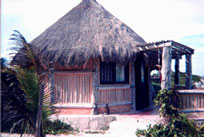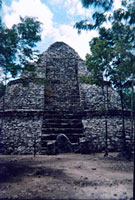
The Best Of Mexico
Boca Paila, Quintana Roo
Cabañas Las Conchita
By Deborah Shepard-McCague
Published March 2002
Dear Carl & Lorena,
You guys are my heroes; I read your book after my first trip to Mexico about 12 years ago and have re-read it countless times. Just like trips to Mexico - I always want to do it again!
I am attaching an article about staying in a palm thatched Mayan casita on the beach of the Boca Paila peninsula. Although located on the Caribbean coast of Mexico only two hours south of Cancun, it is a world away -- simply heaven!
Passing Through Cancun
On the way to Cancun with a plane full of graduating high school seniors, we felt as out of place as Yanni fans at a Limp Bizkit concert. Fortunately our final destination was not one of the mega-resorts in Cancun where the high schoolers were going. Where we were headed there are no laser lighted nightclubs, no glass and marble shopping malls, no beach activity directors, and no beer drinking contests. In fact, there is no electricity, no air conditioning, no phones or television, and no paved roads. But what you will find here are romantic Maya style casitas with palm thatched roofs set right at the water’s edge, miles of pristine beach, and an exotic mixture of nature, history, and culture.
Boca Paila
 We picked up our rental car at the Cancun airport and headed south on the flat, straight Highway 307. In less than two hours, just past the ruins of Tulum, we reached a crossroad with Boca Paila to the left and Coba to the right. Turning left we went about 2 kilometers until the paved road ended at the beach. To the right down a narrow, sandy road we found our rustic little piece of nirvana. Of the several small hotels we chose the cabañas Las Conchita. Although the facilities are basic, there were all the necessities one would need. About fifty feet from our hotel was a casa de cambio for changing our dollars to pesos, several beachfront restaurants, a tiny grocery store with bottled water, drinks and snacks, and a long expanse of almost deserted beach with small coves and rocky points.
We picked up our rental car at the Cancun airport and headed south on the flat, straight Highway 307. In less than two hours, just past the ruins of Tulum, we reached a crossroad with Boca Paila to the left and Coba to the right. Turning left we went about 2 kilometers until the paved road ended at the beach. To the right down a narrow, sandy road we found our rustic little piece of nirvana. Of the several small hotels we chose the cabañas Las Conchita. Although the facilities are basic, there were all the necessities one would need. About fifty feet from our hotel was a casa de cambio for changing our dollars to pesos, several beachfront restaurants, a tiny grocery store with bottled water, drinks and snacks, and a long expanse of almost deserted beach with small coves and rocky points.
Cabañas Las Conchita
Jorge, the hotel owner, graciously showed us all the available cabañas
and allowed us to choose the one we wanted. There were eight units set in a "U" shape facing the beach. We chose cabaña #1, a round, pastel colored, adobe house, barely twenty steps from the water. Big, rough-hewn tree trunks held up the palapa roof and furnishings included a king size bed, draped with mosquito netting, a hand carved wooden desk and chair, lots of candles, a private bathroom, and best of all, a shady terrace with a hammock.
 The nightlife in Cancun is hot, but the words took on a totally different meaning the first night in our beachside casita. Although the windows were open there was hardly a breeze. The air was oppressively hot, heavy and humid. Unfortunately we were visiting during June, one of the warmest and rainiest months of the year. The mosquito netting seemed to trap our hot breath and body heat as we lay flat on our backs in bed like two half melted gumbies. I lay without moving for what seemed like forever when, along with the sound of a wave washing up on the beach, I felt the tiniest breeze waft up just to my toes then retreat. I waited expectantly for the next wave and gradually the sound of the surf increased along with the waves of cool air until I finally drifted off to sleep.
The nightlife in Cancun is hot, but the words took on a totally different meaning the first night in our beachside casita. Although the windows were open there was hardly a breeze. The air was oppressively hot, heavy and humid. Unfortunately we were visiting during June, one of the warmest and rainiest months of the year. The mosquito netting seemed to trap our hot breath and body heat as we lay flat on our backs in bed like two half melted gumbies. I lay without moving for what seemed like forever when, along with the sound of a wave washing up on the beach, I felt the tiniest breeze waft up just to my toes then retreat. I waited expectantly for the next wave and gradually the sound of the surf increased along with the waves of cool air until I finally drifted off to sleep.
Sometime later in the night I awoke with a start. Thunder boomed and I could hear angry waves crashing from all directions; there was a torrent of rain coming down, and for a moment I thought I was on a raft in the middle of the ocean. My first thought was that if the palm frond roof leaks it might become a reality! I was happily amazed the next morning to find our room completely dry and our casita still standing firmly on the beach.
 After a breakfast of fresh tropical fruits, eggs cooked to order, French bread and strong coffee we were off to explore the area. What makes this part of the coastline so interesting besides the tranquility, is the proximity to the pre-Columbian cities of Tulum, perched on a cliff overlooking the sea, and Coba still shrouded by jungle.
After a breakfast of fresh tropical fruits, eggs cooked to order, French bread and strong coffee we were off to explore the area. What makes this part of the coastline so interesting besides the tranquility, is the proximity to the pre-Columbian cities of Tulum, perched on a cliff overlooking the sea, and Coba still shrouded by jungle.
Coba is home to the tallest structure in the Yucatan, the pyramid Nohoc Mul, which is 138 feet high. The road to Coba is dotted with small Maya villages and every few miles a hand painted wooden sign with the word cenote and an arrow pointing down a jungle path. These are sinkholes or caves that reach down to a labyrinth of underground rivers. Some of the cenotes are small and mostly used by local people as swimming holes, but some like the Gran Cenote charge a small admission price and are also popular with divers.
On our way back from Coba, thoroughly hot and exhausted after climbing pyramids and exploring ruins in the steamy, hot jungle we stopped at the Gran Cenote and for the equivalent of fifty cents instantly revived by plunging into the icy, crystal clear watery darkness of the cenote.
 We spent the next day at the Sian Ka’an Biosphere just a few kilometers south along the dirt road. It is a 1.3 million-acre reserve of jungle, mangrove swamps, lagoons, and several small islands just off shore. This protected land is inhabited by a vast number of animals including crocodiles, jaguars, ocelots, flamingos, parrots, toucans, and monkeys. Presently 325 species of birds and 318 species of butterflies have been cataloged within the park's boundaries. A guided tour can be arranged with a biologist, but to protect the ecosystem only a limited number of visitors are allowed each day. Until only recently the area was so remote it made for a perfect hideaway. Just before the entrance is an impressive white mansion at the edge of a bluff overlooking the sea. We were told the house once belonged to the infamous Colombian drug lord Pablo Escobar.
We spent the next day at the Sian Ka’an Biosphere just a few kilometers south along the dirt road. It is a 1.3 million-acre reserve of jungle, mangrove swamps, lagoons, and several small islands just off shore. This protected land is inhabited by a vast number of animals including crocodiles, jaguars, ocelots, flamingos, parrots, toucans, and monkeys. Presently 325 species of birds and 318 species of butterflies have been cataloged within the park's boundaries. A guided tour can be arranged with a biologist, but to protect the ecosystem only a limited number of visitors are allowed each day. Until only recently the area was so remote it made for a perfect hideaway. Just before the entrance is an impressive white mansion at the edge of a bluff overlooking the sea. We were told the house once belonged to the infamous Colombian drug lord Pablo Escobar.
Our last night we walked down to what had become our favorite restaurant - Zama’s. Its open-air dining terrace overlooked a quiet cove. I had a craving for grilled fish and so did a skinny cat who decided to join us. Somehow, in this setting, electricity and the conveniences that are normally so essential, no longer mattered. Here luxury is not measured by 5-stars and triple A’s, but by the hundreds of stars you can almost reach out and touch, by the velvety night breezes, the whisper of the palms, the friendly people, the history and the magic that soothe the body, the mind, and the spirit.
Top of Page
|
|||||||||||||||||||
|
|||||||||||||||||||